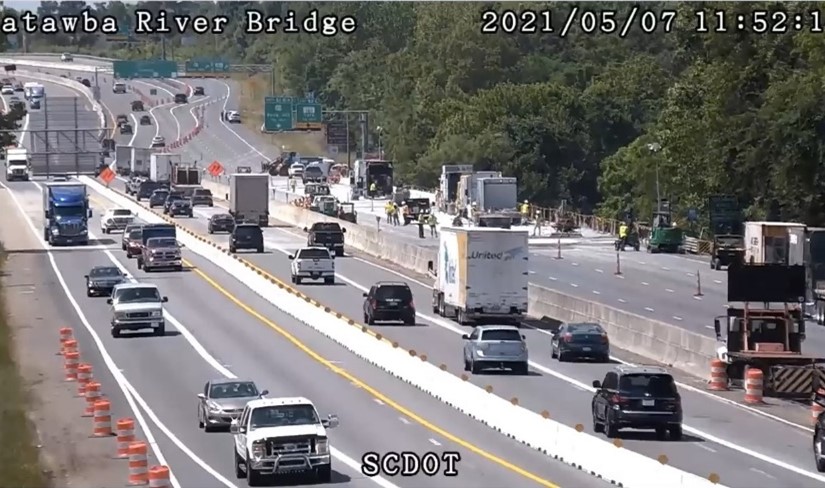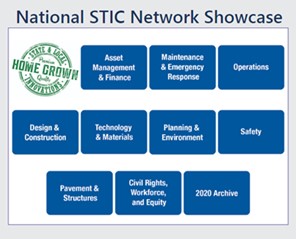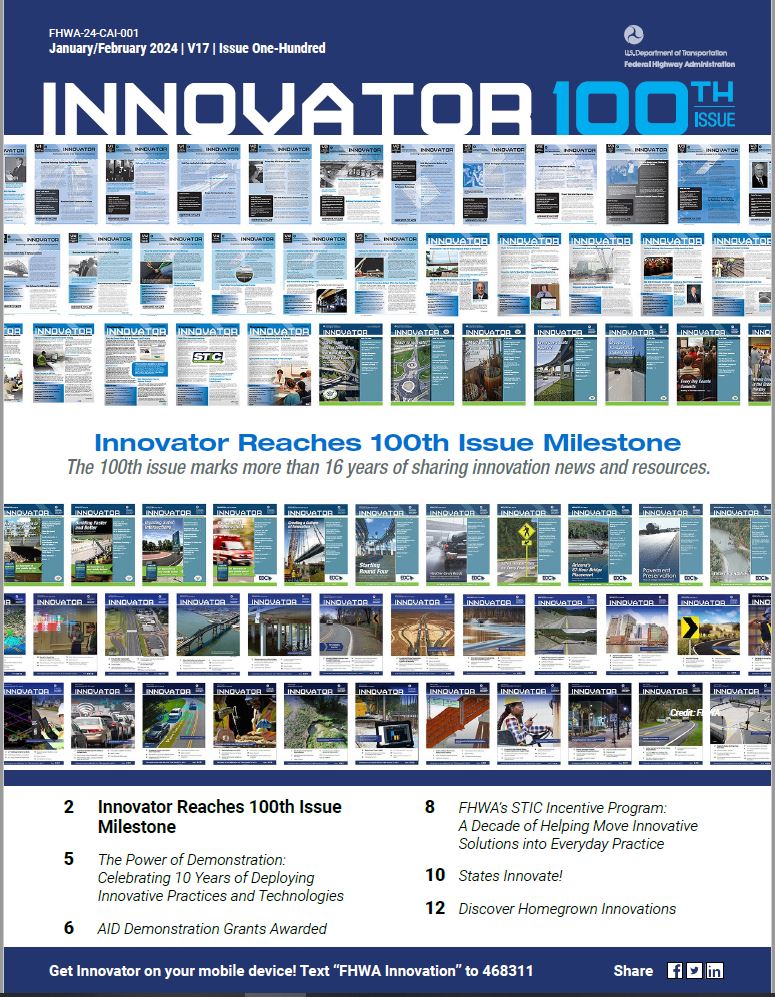February 8, 2024
Innovation of the Month: Crowdsourcing for Advancing Operations
The Interstate 77 Catawba River bridge was built in 1970 and connects a South Carolina bedroom community with Charlotte, NC. When the South Carolina Department of Transportation (SCDOT) determined a full bridge deck replacement was needed on the southbound lanes, the eight-lane highway was going to be reduced to two lanes in each direction, all using the remaining northbound bridge section. From the onset of operational planning, crowdsourced data was an instrumental part in dealing with project-related traffic congestion.

Roadway camera image of traffic diversion at the Catawba River Bridge on I-77. (Credit: SCDOT)
The pre-project planning used a software suite, Iteris® ClearGuide®, that ingests real-time crowdsourced data and provides detailed analysis and visualizations. The route feature in the software allowed SCDOT to understand pre-construction travel times and changes in important metrics like vehicle delay when the project began.
The software's route feature also facilitated alerts that automatically generated emails about total delay and other key management information, providing a quick look into operations while also including a link to access more detailed data. This was important because the software empowered SCDOT supervisors and managers to explore both historical and real-time data and transform it into visualizations. These automated alerts to management also created a more efficient workflow by eliminating the need for traffic management center (TMC) staff to manually notify their management of issues as they occur.
Once the I-77 bridge construction began and the diversion was established, SCDOT analyzed existing signalized interchanges on either end of the bridge using crowdsourced data to optimize timing plans and reduce delays. The average delay tools in the software helped create detailed data about the diversion, enabling traffic engineers to make changes to signal timings, lane shifts, signs, markings, and other operational aspects. The ClearGuide map views of the crowdsourced data helped TMC operators detect and respond to backups, and the bottleneck tool translated the crowdsourced data into user impacts and improvements over time.
One of the enduring uses of crowdsourced data for SCDOT is for automated travel time postings on changeable message signs via the agency advanced traffic management system. The software allows operators to build custom routes that automatically display travel times between roadway points. Normal travel time postings were adjusted for the work zone, truncating the endpoint and simplifying the message. Another change was shifting from traditional peak hour postings only to posting travel times 24-hours per day, seven days per week for the Catawba River bridge.
For more information on this project, please visit Case Study: South Carolina Department of Transportation Uses Analytics Tools To Maximize Crowdsourced Data. To learn more about crowdsourcing, contact James Colyar, FHWA Office of Operations, or Greg Jones, FHWA Resource Center.
Notice: The U.S. Government does not endorse products or manufacturers. Trademarks or manufacturers’ names appear in this presentation only because they are considered essential to the objective of the presentation. They are included for informational purposes only and are not intended to reflect a preference, approval, or endorsement of any one product or entity.
A Total Solar Eclipse is coming – is your agency ready?
On Monday, April 8, 2024, a total solar eclipse will make its way across the continental United States. The path of totality – when the moon fully blocks the sun's light – will enter the United States through Texas and travel from Oklahoma, Arkansas, Missouri, Illinois, Kentucky, Indiana, Ohio, Pennsylvania, New York, Vermont, New Hampshire, and Maine before it passes through Canada. This rare event is expected to bring millions of visitors to the path, resulting in significant disruptions and congestion. Viewing the total solar eclipse is dependent on fair weather conditions. Forecasted, or day of, cloud cover or precipitation could cause significant last-minute shifts in travel for many viewers and greatly increase pre-event travel impacts.
To better prepare for these anticipated impacts, transportation agencies can implement Pathfinder. Part of the EDC-4 Weather-Savvy Roads (WSR) initiative, Pathfinder is a collaborative strategy for proactive transportation system management ahead of and during weather events. Pathfinder can play an important role in any major planned special event that could be impacted by changes in weather. It encourages transportation agencies to work with their local National Weather Service field offices, weather service providers, and emergency management partners, to share and translate weather forecasts and road conditions into consistent transportation impact messages for the public.
EDC-5’s Weather-Responsive Management Strategies (WRMS) can also be used before, during, and after the eclipse to provide dynamic, real-time information to travelers through roadside messaging, mobile, and connected vehicle technologies. Better information to travelers enables more informed travel decisions resulting in improved safety and mobility.
Learn more about how to prepare for the upcoming eclipse by participating in the upcoming preparation webinar, February 21, 2024, from 1 to 4 p.m. ET., where FHWA and its partners will discuss strategies, resources, tools, and innovations that can be used to prepare for the upcoming solar eclipse! Register here.
For additional information check out the following resources:
- WSR: What is Pathfinder?
- WSR: Pathfinder: Implementation Recommendations
- WSR: Wyoming Department of Transportation Total Solar Eclipse
- WRMS: Transportation Agency Deployment
Strategic Workforce Development- Working with Local Departments of Labor (DOL) or Workforce Boards
To identify, train, place, and retain qualified individuals into needed transportation workforce roles, it is essential for State departments of transportation to connect with State and local workforce boards, their respective State departments of labor, and the U.S. Department of Labor. Collaborating with these workforce boards is crucial to keeping our nation's transportation industry moving forward.
Workforce board partnerships can bring together highway construction, education, and workforce interests to identify needs and resources to fill industry workforce gaps. The U.S. Department of Labor's Workforce Innovation and Opportunity Act (WIOA) helps match employers with the skilled workers they need. Through WIOA, workforce boards align their programs with needs specific to local industries and job seekers. To learn more about what WIOA can do for your agency, read the program factsheet here.
To learn more about Strategic Workforce Development please contact Chrisy Currier, FHWA Office of Infrastructure.
Discover Home-Grown Innovations from Around the Country

Are you interested in homegrown innovations being used by your peers in other parts of the country? Check out the National STIC Network Showcase, a component of the EDC-7 Virtual Summit. Don’t miss your opportunity to view all the content through the end of this month! After February, a summary of STIC Showcase entries will be available for reference.

Learn about the Maine Department of Transportation's Harris Inspection Tool. This telescoping tool, also known as the HIT Rod, enables bridge inspectors to inspect bridge elements that would otherwise require expensive equipment and often traffic control to see. The State estimates savings of up to $5,000 per inspection each time this $800 tool is used.
Celebrate the ingenuity of your peers and read about these innovations—developed and deployed in-house at transportation agencies nationwide. Additionally, we invite you to watch the one-hour presentations on-demand that feature many of these and other innovations.
100th Innovator Issue Now Available!
The January/February issue of Innovator is now available, accessible from your computer, tablet, or mobile phone to optimize your reading experience!
Read past issues and sign up to receive Innovator by email here, or text "FHWA Innovation" to 468311 to get Innovator on your smartphone.
Stay Up to Date on the EDC Innovations That Interest You Most

EDC teams are always on the move! If you blink, you could miss out on important webinars, case studies, tools, videos, and more. To never miss information for the EDC innovations that interest you most, visit the subscription page and select the topics you’d like to receive updates on directly from the teams that coordinate them.
Recent bulletins:
Build a Better Mousetrap 1/25/24
Road Weather Management 1/31/24
CHANGE 2/1/24
Integrating GHG 2/1/24
Upcoming Events
Build a Better Mousetrap State Winners
February 15, 2024, 2:00pm ET Details
About EDC
Every Day Counts, a State-based initiative of the Federal Highway Administration's Office of Innovation and Workforce Solutions, works with State, local, and privatesector partners to encourage the adoption of proven and underutilized technologies to deliver transportation projects more efficiently, enhance safety forall users, support a sustainable and resilient infrastructure, and incorporate equity inproject planning and delivery.
EDC News is a weekly publication highlighting successful EDC innovation deployments across the country.
EDC News is published weekly by the FHWA Center for Accelerating Innovation.
Disclaimer:The U.S. Government does not endorse products or manufacturers. Trademarks or manufacturers' names appear in this document only because they are considered essential to the objective of the document. They are included for informational purposes only and are not intended to reflect a preference, approval, or endorsement of any one product or entity.
Except for the statutes and regulations cited, the contents of this document do not have the force and effect of law and are not meant to bind the States or the public in any way. This document is intended only to provide information regarding existing requirements under the law or agency policies.
Recommended Citation:
U.S Department of Transportation, Federal Highway Administration
EDC News; February 8, 2024
Washington, DC




